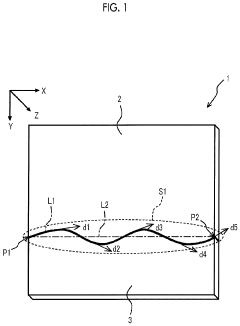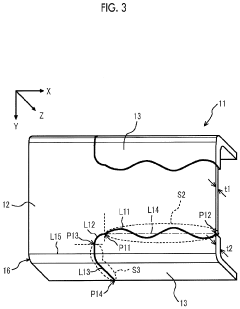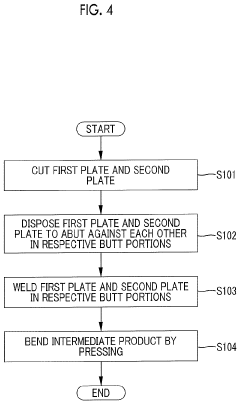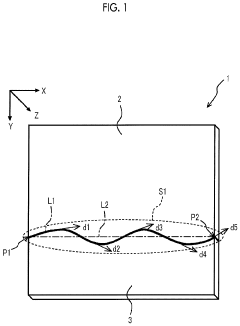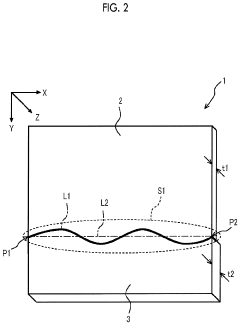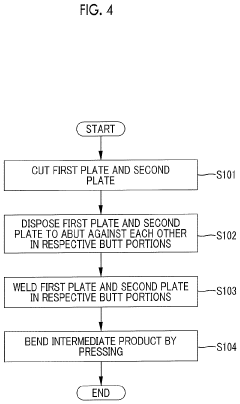Improving Efficiency in Butt Welding: Material Compatibility Insights
MAY 12, 202510 MIN READ
Generate Your Research Report Instantly with AI Agent
Patsnap Eureka helps you evaluate technical feasibility & market potential.
Butt Welding Efficiency Evolution and Objectives
Butt welding, a fundamental joining technique in manufacturing and construction, has undergone significant evolution since its inception. The process, which involves joining two pieces of material end-to-end, has seen continuous improvements in efficiency, precision, and material compatibility. The journey of butt welding efficiency began with manual techniques and has progressed to highly automated systems, incorporating advanced technologies such as laser and electron beam welding. This evolution has been driven by the increasing demands of industries for stronger, more reliable, and cost-effective joining methods.
The primary objective in improving butt welding efficiency is to enhance the quality of the weld while minimizing time, energy consumption, and material waste. This involves optimizing various parameters such as heat input, welding speed, and material preparation. A key focus has been on developing techniques that can handle a wider range of materials, including dissimilar metals and advanced alloys, which pose unique challenges in terms of thermal conductivity and melting points.
Recent technological advancements have led to the integration of real-time monitoring systems and adaptive control mechanisms. These innovations aim to maintain consistent weld quality by adjusting welding parameters on-the-fly based on sensor feedback. The incorporation of artificial intelligence and machine learning algorithms is further pushing the boundaries of what's possible in butt welding efficiency.
Material compatibility insights have played a crucial role in this evolution. Understanding the metallurgical interactions between different materials during the welding process has led to the development of specialized filler materials and welding techniques. This knowledge has been instrumental in expanding the application of butt welding to new industries and materials, such as in the aerospace sector where joining of lightweight alloys is critical.
Looking ahead, the objectives for further improving butt welding efficiency are multifaceted. There is a strong focus on developing more energy-efficient processes, particularly important in the context of sustainability and reducing carbon footprints in manufacturing. Another key objective is to enhance the automation and integration of butt welding processes into smart manufacturing systems, aligning with Industry 4.0 principles. Additionally, there's a push towards improving the portability and flexibility of butt welding equipment, enabling its use in diverse environments and applications.
The ongoing research in material science also aims to develop new alloys and composites that are more amenable to butt welding, potentially revolutionizing the types of products and structures that can be created. As industries continue to demand stronger, lighter, and more complex components, the evolution of butt welding efficiency remains a critical area of technological development, promising to unlock new possibilities in manufacturing and construction.
The primary objective in improving butt welding efficiency is to enhance the quality of the weld while minimizing time, energy consumption, and material waste. This involves optimizing various parameters such as heat input, welding speed, and material preparation. A key focus has been on developing techniques that can handle a wider range of materials, including dissimilar metals and advanced alloys, which pose unique challenges in terms of thermal conductivity and melting points.
Recent technological advancements have led to the integration of real-time monitoring systems and adaptive control mechanisms. These innovations aim to maintain consistent weld quality by adjusting welding parameters on-the-fly based on sensor feedback. The incorporation of artificial intelligence and machine learning algorithms is further pushing the boundaries of what's possible in butt welding efficiency.
Material compatibility insights have played a crucial role in this evolution. Understanding the metallurgical interactions between different materials during the welding process has led to the development of specialized filler materials and welding techniques. This knowledge has been instrumental in expanding the application of butt welding to new industries and materials, such as in the aerospace sector where joining of lightweight alloys is critical.
Looking ahead, the objectives for further improving butt welding efficiency are multifaceted. There is a strong focus on developing more energy-efficient processes, particularly important in the context of sustainability and reducing carbon footprints in manufacturing. Another key objective is to enhance the automation and integration of butt welding processes into smart manufacturing systems, aligning with Industry 4.0 principles. Additionally, there's a push towards improving the portability and flexibility of butt welding equipment, enabling its use in diverse environments and applications.
The ongoing research in material science also aims to develop new alloys and composites that are more amenable to butt welding, potentially revolutionizing the types of products and structures that can be created. As industries continue to demand stronger, lighter, and more complex components, the evolution of butt welding efficiency remains a critical area of technological development, promising to unlock new possibilities in manufacturing and construction.
Market Demand for Advanced Butt Welding Solutions
The demand for advanced butt welding solutions has been steadily increasing across various industries, driven by the need for improved efficiency, quality, and cost-effectiveness in manufacturing processes. As industries continue to evolve and adopt more sophisticated materials and designs, the market for innovative butt welding technologies is experiencing significant growth. This trend is particularly evident in sectors such as automotive, aerospace, construction, and energy, where the joining of materials plays a crucial role in product performance and reliability.
One of the primary drivers of market demand is the growing use of lightweight and high-strength materials in manufacturing. As industries strive to reduce weight and improve fuel efficiency, there is an increasing need for welding solutions that can effectively join dissimilar materials without compromising structural integrity. This has led to a surge in demand for advanced butt welding techniques that can handle materials such as aluminum alloys, high-strength steels, and composite materials.
Another factor contributing to market growth is the push for automation and Industry 4.0 integration in manufacturing processes. Companies are seeking butt welding solutions that can be easily integrated into automated production lines, offering higher precision, consistency, and productivity. This has created a market for smart welding systems equipped with sensors, real-time monitoring capabilities, and data analytics features that can optimize welding parameters and ensure consistent quality.
The global focus on sustainability and energy efficiency has also influenced market demand for advanced butt welding solutions. Industries are looking for welding technologies that can reduce energy consumption, minimize material waste, and improve overall process efficiency. This has led to increased interest in technologies such as laser welding, friction stir welding, and electron beam welding, which offer advantages in terms of energy efficiency and material conservation.
In terms of market size, the global welding equipment and consumables market, which includes butt welding solutions, was valued at approximately $25 billion in 2020 and is projected to reach $32 billion by 2025, growing at a CAGR of around 5%. The Asia-Pacific region is expected to witness the highest growth rate, driven by rapid industrialization and infrastructure development in countries like China and India.
Key market players are focusing on research and development to introduce innovative butt welding solutions that address the evolving needs of various industries. There is a growing emphasis on developing welding technologies that can handle complex geometries, improve weld quality, and reduce post-weld processing requirements. Additionally, there is increasing demand for portable and versatile welding equipment that can be used in diverse applications and environments.
One of the primary drivers of market demand is the growing use of lightweight and high-strength materials in manufacturing. As industries strive to reduce weight and improve fuel efficiency, there is an increasing need for welding solutions that can effectively join dissimilar materials without compromising structural integrity. This has led to a surge in demand for advanced butt welding techniques that can handle materials such as aluminum alloys, high-strength steels, and composite materials.
Another factor contributing to market growth is the push for automation and Industry 4.0 integration in manufacturing processes. Companies are seeking butt welding solutions that can be easily integrated into automated production lines, offering higher precision, consistency, and productivity. This has created a market for smart welding systems equipped with sensors, real-time monitoring capabilities, and data analytics features that can optimize welding parameters and ensure consistent quality.
The global focus on sustainability and energy efficiency has also influenced market demand for advanced butt welding solutions. Industries are looking for welding technologies that can reduce energy consumption, minimize material waste, and improve overall process efficiency. This has led to increased interest in technologies such as laser welding, friction stir welding, and electron beam welding, which offer advantages in terms of energy efficiency and material conservation.
In terms of market size, the global welding equipment and consumables market, which includes butt welding solutions, was valued at approximately $25 billion in 2020 and is projected to reach $32 billion by 2025, growing at a CAGR of around 5%. The Asia-Pacific region is expected to witness the highest growth rate, driven by rapid industrialization and infrastructure development in countries like China and India.
Key market players are focusing on research and development to introduce innovative butt welding solutions that address the evolving needs of various industries. There is a growing emphasis on developing welding technologies that can handle complex geometries, improve weld quality, and reduce post-weld processing requirements. Additionally, there is increasing demand for portable and versatile welding equipment that can be used in diverse applications and environments.
Current Challenges in Material Compatibility for Butt Welding
Butt welding, a critical process in various industries, faces significant challenges when it comes to material compatibility. The primary issue lies in the diverse range of materials used in modern manufacturing, each with unique properties and behaviors during the welding process. One of the most pressing challenges is the formation of intermetallic compounds at the weld interface, particularly when joining dissimilar metals. These compounds can lead to brittle welds, reduced strength, and increased susceptibility to corrosion. Additionally, the difference in thermal expansion coefficients between materials can result in residual stresses and distortion, compromising the integrity of the welded joint.
Another significant challenge is the management of heat input during the welding process. Excessive heat can lead to grain growth in the heat-affected zone, altering the material's microstructure and potentially weakening the joint. Conversely, insufficient heat may result in incomplete fusion and poor weld penetration. This delicate balance is further complicated when dealing with materials that have vastly different melting points or thermal conductivities.
The presence of surface oxides and contaminants poses another hurdle in achieving optimal material compatibility. These impurities can lead to porosity, inclusions, and other weld defects that compromise the joint's strength and durability. Furthermore, certain materials, such as aluminum and magnesium alloys, form tenacious oxide layers that require specialized cleaning and preparation techniques to ensure proper fusion.
In the realm of high-performance materials, such as advanced high-strength steels and titanium alloys, maintaining the desired mechanical properties after welding presents a significant challenge. These materials often rely on carefully controlled microstructures that can be easily disrupted by the heat and rapid cooling cycles inherent in the welding process.
The increasing use of composite materials and metal matrix composites in various industries has introduced new compatibility challenges. These materials often exhibit anisotropic properties and can be sensitive to thermal degradation, making traditional welding approaches less effective or even detrimental.
Lastly, the push towards miniaturization in many industries has led to the need for precise, small-scale welding techniques. Achieving consistent material compatibility at these reduced scales presents unique challenges, particularly in terms of heat control and preventing material degradation.
Addressing these challenges requires a multifaceted approach, combining advanced material science, process optimization, and innovative welding technologies. Ongoing research in areas such as laser welding, friction stir welding, and cold metal transfer holds promise for overcoming many of these compatibility issues, paving the way for more efficient and reliable butt welding processes across a wider range of materials.
Another significant challenge is the management of heat input during the welding process. Excessive heat can lead to grain growth in the heat-affected zone, altering the material's microstructure and potentially weakening the joint. Conversely, insufficient heat may result in incomplete fusion and poor weld penetration. This delicate balance is further complicated when dealing with materials that have vastly different melting points or thermal conductivities.
The presence of surface oxides and contaminants poses another hurdle in achieving optimal material compatibility. These impurities can lead to porosity, inclusions, and other weld defects that compromise the joint's strength and durability. Furthermore, certain materials, such as aluminum and magnesium alloys, form tenacious oxide layers that require specialized cleaning and preparation techniques to ensure proper fusion.
In the realm of high-performance materials, such as advanced high-strength steels and titanium alloys, maintaining the desired mechanical properties after welding presents a significant challenge. These materials often rely on carefully controlled microstructures that can be easily disrupted by the heat and rapid cooling cycles inherent in the welding process.
The increasing use of composite materials and metal matrix composites in various industries has introduced new compatibility challenges. These materials often exhibit anisotropic properties and can be sensitive to thermal degradation, making traditional welding approaches less effective or even detrimental.
Lastly, the push towards miniaturization in many industries has led to the need for precise, small-scale welding techniques. Achieving consistent material compatibility at these reduced scales presents unique challenges, particularly in terms of heat control and preventing material degradation.
Addressing these challenges requires a multifaceted approach, combining advanced material science, process optimization, and innovative welding technologies. Ongoing research in areas such as laser welding, friction stir welding, and cold metal transfer holds promise for overcoming many of these compatibility issues, paving the way for more efficient and reliable butt welding processes across a wider range of materials.
Existing Solutions for Enhancing Butt Welding Efficiency
01 Improved welding equipment design
Enhancing butt welding efficiency through advanced equipment design, including optimized welding heads, automated positioning systems, and improved heat distribution mechanisms. These innovations lead to faster welding speeds, reduced setup times, and more consistent weld quality.- Improved welding equipment design: Enhancing butt welding efficiency through innovative equipment design, including specialized fixtures, automated systems, and precision control mechanisms. These advancements allow for better alignment, reduced setup time, and improved weld quality, ultimately increasing overall efficiency in the butt welding process.
- Optimized welding parameters: Focusing on the optimization of welding parameters such as current, voltage, and speed to achieve higher efficiency in butt welding. This includes developing adaptive control systems that can adjust parameters in real-time based on material properties and joint characteristics, resulting in improved weld quality and reduced processing time.
- Advanced material preparation techniques: Implementing advanced material preparation techniques to enhance butt welding efficiency. This involves improved edge preparation methods, cleaning processes, and the use of specialized coatings or fluxes that facilitate better weld penetration and reduce the likelihood of defects, leading to higher-quality welds and increased productivity.
- Innovative joint designs: Developing innovative joint designs specifically tailored for butt welding applications. These designs aim to improve weld strength, reduce material consumption, and minimize the need for post-weld processing. By optimizing the geometry of the joint, welding efficiency can be significantly increased while maintaining or enhancing the structural integrity of the welded components.
- Integration of monitoring and quality control systems: Incorporating advanced monitoring and quality control systems into the butt welding process. These systems utilize sensors, machine vision, and data analytics to provide real-time feedback on weld quality, detect defects, and enable immediate corrective actions. By minimizing rework and ensuring consistent weld quality, overall efficiency in butt welding operations is improved.
02 Advanced welding process control
Implementing sophisticated process control systems to monitor and adjust welding parameters in real-time. This includes adaptive control algorithms, sensor-based feedback systems, and intelligent power source management, resulting in improved weld quality and reduced defects.Expand Specific Solutions03 Innovative joint preparation techniques
Developing new methods for preparing joint surfaces prior to butt welding, such as advanced cleaning processes, precision edge preparation, and specialized surface treatments. These techniques enhance weld penetration, reduce contamination, and improve overall weld strength.Expand Specific Solutions04 Optimization of filler materials
Formulating and selecting improved filler materials tailored for specific butt welding applications. This includes developing new alloy compositions, optimizing wire feed rates, and enhancing material compatibility to achieve stronger welds and faster welding speeds.Expand Specific Solutions05 Integration of automation and robotics
Incorporating advanced automation and robotic systems into butt welding processes. This includes the use of collaborative robots, vision-guided welding systems, and automated quality inspection tools to increase productivity, consistency, and overall welding efficiency.Expand Specific Solutions
Key Players in Butt Welding Industry and Research
The competitive landscape for improving efficiency in butt welding, particularly regarding material compatibility, is characterized by a mature market with significant growth potential. The industry is in a consolidation phase, with major players like NIPPON STEEL CORP., ArcelorMittal SA, and JFE Steel Corp. leading technological advancements. The market size is substantial, driven by demand from automotive, shipbuilding, and construction sectors. Companies such as Toyota Motor Corp. and Hyundai Steel Co. are investing heavily in research and development to enhance welding efficiency and material compatibility. The technology maturity varies, with established firms like IHI Corp. and POSCO Holdings, Inc. offering advanced solutions, while newer entrants like Wuhan Raycus Fiber Laser Technologies Co., Ltd. are introducing innovative approaches, indicating a dynamic and competitive environment.
POSCO Holdings, Inc.
Technical Solution: POSCO Holdings, Inc. has focused on improving butt welding efficiency through the development of a multi-stage welding process specifically designed for challenging material combinations. Their approach involves a pre-welding treatment stage where the surfaces to be joined are prepared using a combination of mechanical and chemical processes to optimize surface conditions. The actual welding process uses a pulsed power supply that allows for precise control of heat input, reducing the risk of material property degradation. Post-welding, POSCO employs a rapid cooling system combined with localized heat treatment to fine-tune the microstructure of the welded joint. They have also developed a suite of non-destructive testing methods to ensure weld quality and material compatibility.
Strengths: Comprehensive process from pre-welding to post-weld treatment, advanced quality control measures. Weaknesses: Potentially longer processing time due to multiple stages, may require more complex equipment setup.
JFE Steel Corp.
Technical Solution: JFE Steel Corp. has focused on improving butt welding efficiency through the development of novel filler materials and welding processes. Their approach involves the use of specially formulated filler metals that are designed to create a smooth transition between different base materials. These fillers are engineered to match the mechanical and chemical properties of the materials being joined, reducing the risk of incompatibility issues. JFE Steel has also developed a hybrid welding process that combines traditional arc welding with high-frequency vibration, which helps to refine the grain structure at the weld interface and improve overall joint strength.
Strengths: Innovative filler materials, improved metallurgical properties of welds. Weaknesses: May require specific filler materials for each application, potential for increased material costs.
Innovative Approaches to Material Compatibility in Butt Welding
Metal member and method of manufacturing the same
PatentActiveUS20220314368A1
Innovation
- The welding boundary line is made longer than a straight line connecting its ends, allowing for increased joint area and strength without adding more butt portions, and the thickness of plates can be varied to optimize strength and weight, with a curved portion connecting butt portions to prevent interference during bending.
Metal member and method of manufacturing the same
PatentActiveUS11833612B2
Innovation
- The welding boundary line is made longer than a straight line connecting the ends, allowing for increased joint area and strength without adding more butt portions, and the thickness of plates can vary to optimize strength and weight, with a curved portion connecting butt portions to prevent interference during bending.
Environmental Impact of Butt Welding Processes
The environmental impact of butt welding processes is a critical consideration in modern manufacturing and construction industries. As sustainability becomes increasingly important, understanding and mitigating the ecological footprint of welding operations is essential. Butt welding, while an efficient joining method, can have significant environmental implications.
One of the primary environmental concerns associated with butt welding is the emission of fumes and gases. These emissions can contain harmful substances such as metal oxides, ozone, and various volatile organic compounds (VOCs). The composition and quantity of these emissions vary depending on the materials being welded, the welding process used, and the specific parameters of the operation. For instance, welding stainless steel can release chromium and nickel compounds, which are known to have potential carcinogenic effects.
Energy consumption is another significant factor contributing to the environmental impact of butt welding. The process typically requires high amounts of electricity or fuel, depending on the power source used. This energy demand not only increases operational costs but also contributes to greenhouse gas emissions if the energy is sourced from non-renewable sources. The carbon footprint of butt welding operations can be substantial, especially in large-scale industrial applications.
Waste generation is an additional environmental concern in butt welding processes. This includes not only the direct waste from welding consumables but also indirect waste such as packaging materials and worn-out equipment. Proper disposal and recycling of welding waste, particularly for materials containing heavy metals or other hazardous substances, is crucial to minimize environmental contamination.
Water usage and potential water pollution are also important considerations. Some welding processes may require cooling systems that consume significant amounts of water. Additionally, improper handling of welding waste or accidental spills can lead to water contamination, affecting local ecosystems and water resources.
To address these environmental challenges, the industry is increasingly focusing on developing more sustainable butt welding practices. This includes the adoption of cleaner welding technologies, such as those that produce fewer emissions or require less energy. Improved fume extraction and filtration systems are being implemented to reduce air pollution. Additionally, there is a growing emphasis on using more environmentally friendly welding consumables and optimizing processes to minimize waste generation.
The shift towards more sustainable butt welding practices also involves considering the entire lifecycle of welded products. This includes selecting materials that are more easily recyclable and designing products for easier disassembly at the end of their life. Furthermore, advancements in welding automation and precision control are helping to reduce material waste and improve energy efficiency.
As environmental regulations become more stringent globally, manufacturers and construction companies are increasingly required to assess and report on the environmental impact of their welding operations. This has led to a greater focus on life cycle assessments and the development of more comprehensive environmental management systems in industries relying heavily on butt welding processes.
One of the primary environmental concerns associated with butt welding is the emission of fumes and gases. These emissions can contain harmful substances such as metal oxides, ozone, and various volatile organic compounds (VOCs). The composition and quantity of these emissions vary depending on the materials being welded, the welding process used, and the specific parameters of the operation. For instance, welding stainless steel can release chromium and nickel compounds, which are known to have potential carcinogenic effects.
Energy consumption is another significant factor contributing to the environmental impact of butt welding. The process typically requires high amounts of electricity or fuel, depending on the power source used. This energy demand not only increases operational costs but also contributes to greenhouse gas emissions if the energy is sourced from non-renewable sources. The carbon footprint of butt welding operations can be substantial, especially in large-scale industrial applications.
Waste generation is an additional environmental concern in butt welding processes. This includes not only the direct waste from welding consumables but also indirect waste such as packaging materials and worn-out equipment. Proper disposal and recycling of welding waste, particularly for materials containing heavy metals or other hazardous substances, is crucial to minimize environmental contamination.
Water usage and potential water pollution are also important considerations. Some welding processes may require cooling systems that consume significant amounts of water. Additionally, improper handling of welding waste or accidental spills can lead to water contamination, affecting local ecosystems and water resources.
To address these environmental challenges, the industry is increasingly focusing on developing more sustainable butt welding practices. This includes the adoption of cleaner welding technologies, such as those that produce fewer emissions or require less energy. Improved fume extraction and filtration systems are being implemented to reduce air pollution. Additionally, there is a growing emphasis on using more environmentally friendly welding consumables and optimizing processes to minimize waste generation.
The shift towards more sustainable butt welding practices also involves considering the entire lifecycle of welded products. This includes selecting materials that are more easily recyclable and designing products for easier disassembly at the end of their life. Furthermore, advancements in welding automation and precision control are helping to reduce material waste and improve energy efficiency.
As environmental regulations become more stringent globally, manufacturers and construction companies are increasingly required to assess and report on the environmental impact of their welding operations. This has led to a greater focus on life cycle assessments and the development of more comprehensive environmental management systems in industries relying heavily on butt welding processes.
Quality Control Measures in Butt Welding Operations
Quality control is a critical aspect of butt welding operations, ensuring the integrity and reliability of the welded joints. To maintain high standards in butt welding, a comprehensive set of quality control measures must be implemented throughout the welding process. These measures typically begin with thorough material inspection and preparation, including cleaning and proper alignment of the workpieces. Prior to welding, it is essential to verify that the welding equipment is calibrated and functioning correctly, with all necessary parameters set according to the welding procedure specification (WPS).
During the welding process, real-time monitoring of key variables such as temperature, current, voltage, and travel speed is crucial. Advanced welding systems often incorporate sensors and data logging capabilities to track these parameters continuously. Visual inspection by skilled welders or automated vision systems can detect surface defects or irregularities as they occur, allowing for immediate corrective action.
Post-welding quality control measures are equally important. Non-destructive testing (NDT) methods, such as radiographic testing, ultrasonic testing, or magnetic particle inspection, are commonly employed to detect internal defects or discontinuities in the weld. These techniques provide valuable insights into the weld's internal structure without compromising its integrity. Destructive testing, while less frequent, may be performed on sample welds to assess mechanical properties such as tensile strength, ductility, and impact resistance.
Documentation and traceability play a vital role in quality control. Each weld should be assigned a unique identifier, with all relevant information recorded, including welder identification, date, time, materials used, and welding parameters. This documentation not only aids in quality assurance but also facilitates root cause analysis in the event of any issues.
Continuous improvement is an integral part of quality control in butt welding. Regular analysis of welding data, defect rates, and production efficiency can identify trends and areas for improvement. This may lead to refinements in welding procedures, equipment upgrades, or additional training for welding personnel.
Implementing a robust quality management system, such as ISO 9001 or industry-specific standards, provides a framework for consistent quality control practices. These systems often include regular audits, both internal and external, to ensure compliance with established procedures and identify opportunities for enhancement.
By implementing these comprehensive quality control measures, manufacturers can significantly reduce the occurrence of welding defects, improve overall product quality, and enhance customer satisfaction. The investment in quality control not only minimizes costly rework and material waste but also contributes to the long-term reputation and success of the welding operation.
During the welding process, real-time monitoring of key variables such as temperature, current, voltage, and travel speed is crucial. Advanced welding systems often incorporate sensors and data logging capabilities to track these parameters continuously. Visual inspection by skilled welders or automated vision systems can detect surface defects or irregularities as they occur, allowing for immediate corrective action.
Post-welding quality control measures are equally important. Non-destructive testing (NDT) methods, such as radiographic testing, ultrasonic testing, or magnetic particle inspection, are commonly employed to detect internal defects or discontinuities in the weld. These techniques provide valuable insights into the weld's internal structure without compromising its integrity. Destructive testing, while less frequent, may be performed on sample welds to assess mechanical properties such as tensile strength, ductility, and impact resistance.
Documentation and traceability play a vital role in quality control. Each weld should be assigned a unique identifier, with all relevant information recorded, including welder identification, date, time, materials used, and welding parameters. This documentation not only aids in quality assurance but also facilitates root cause analysis in the event of any issues.
Continuous improvement is an integral part of quality control in butt welding. Regular analysis of welding data, defect rates, and production efficiency can identify trends and areas for improvement. This may lead to refinements in welding procedures, equipment upgrades, or additional training for welding personnel.
Implementing a robust quality management system, such as ISO 9001 or industry-specific standards, provides a framework for consistent quality control practices. These systems often include regular audits, both internal and external, to ensure compliance with established procedures and identify opportunities for enhancement.
By implementing these comprehensive quality control measures, manufacturers can significantly reduce the occurrence of welding defects, improve overall product quality, and enhance customer satisfaction. The investment in quality control not only minimizes costly rework and material waste but also contributes to the long-term reputation and success of the welding operation.
Unlock deeper insights with Patsnap Eureka Quick Research — get a full tech report to explore trends and direct your research. Try now!
Generate Your Research Report Instantly with AI Agent
Supercharge your innovation with Patsnap Eureka AI Agent Platform!
